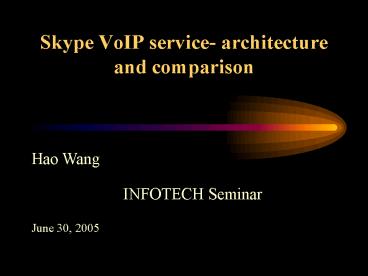Skype VoIP service- architecture and comparison PowerPoint PPT Presentation
1 / 19
Title: Skype VoIP service- architecture and comparison
1
Skype VoIP service- architecture and comparison
Hao Wang
INFOTECH Seminar June 30, 2005
2
Agenda
- 1. Background knowledge of VoIP
Architecture and components - 2. Skype A P2P VoIP Service
- What is peer-to-peer ?
- Skype Introduction and Overview
- 3. Comparison of different scenarios between
Skype and VoIP - Login, NAT and Firewall Traversal, User
Search, - Call Establishment and Teardown, Media
Transfer and Codecs, Security
3
VoIP Network
Signaling protocols H.323, SIP
Data transfer Real-time Transport Protocol.
4
VoIP Transmission
- Step 1 The callers voice is digitized.
- Step 2 Digital voice is compressed and then
separated into packets the packets are
addressed and sent across the network. - Step3 Error detection and correction systems are
used to create sound to fill in the gaps. - Step4 Restore the data to an approximation of
the original form.
5
Skype Peer-to-peer internet telephony (VoIP)
network
A pure peer-to-peer network only have equal peer
nodes that simultaneously function as both
"clients" and "servers" to the other nodes on
the network.
6
Main Difference
- The main difference between Skype and other VoIP
clients is that it operates on a peer-to-peer
model rather than the more traditional
server-client model.
7
Login Process
- VoIP A client may only have to authenticate its
user name and password with login server. - Skype
- Connects to a Super Node
- Determines the type of NAT and firewall
- Discovers online Skype nodes with public IP
addresses (Alternate Node Table)
8
NAT and Firewall
- VoIP
- NAT port forwarding manual configuration or via
UPnP (Universal Plug and Play) - STUN protocol (Simple Traversal of User Datagram
Protocol) - ALG (Application Layer Gateway)
9
NAT and Firewall
- Skype
- Variation of typical schemes such as STUN
- Natural and elegant, involving little management
structure and overhead.
10
User Search
- SIP caller will search the users by asking the
SIP server - Skype
- Perhaps use Chord like hash-based methods,
- combined with traditional blind searching
techniques. - SN acts like a search proxy for SC and caches
searched results.
11
Call Establishment and Teardown
- Process in SIP
- The SIP proxy uses
- DNS to find the SIP
- registrar of Bob .
12
Call Establishment and Teardown
- Process in Skype
- Call signaling is always carried over TCP.
- Call placement is equal to user search plus call
signaling. - If users are behind port restricted NAT and
UDP-restricted firewall, both caller and callee
SC exchange signaling information over TCP with
another online Skype node.
13
Media Transfer
- VoIP
- H.323 and SIP are only the signaling protocols.
Audio data is carried using RTP (Real-time
Transport Protocol). - Skype
- The Skype protocol seems to prefer the use of UDP
for voice transmission as much as possible. If
not possible , it will make use of TCP .
14
Codecs
- VoIP
- Various standards
- Compress the data stream
- Silence suppression
- Skype
- Global IP Sound multiple description coding,
- variable bit-rate
- No silence suppression
15
Security in VoIP
- IP security
- IPsec is a suite of protocols to provide
security services on the network layer in IP
based networks. - Often in combination with VPN (Virtual Private
Network ) - Firewall
- Located at border to public Internet
- Control incoming and outgoing traffic
16
Security in Skype
- Skype is encrypted end-to-end
- Skype uses AES (Advanced Encryption Standard) to
protect sensitive information. - Skype uses 1024 bit RSA to negotiate symmetric
AES keys. - User public keys are certified by the Skype
server at login.
17
Conclusions
- Skype is a successful combination of several
technologies basic on p2p overlay networks - Much better voice quality, ability to traverse
the NAT and firewalls, encrypted media channel - Ability to scale up to handle large-scale
connection-oriented real-time services - Heavy software based DSP operations at Skype
clients
18
d
- Q A Session
19
D
- Thank you for your attention!

